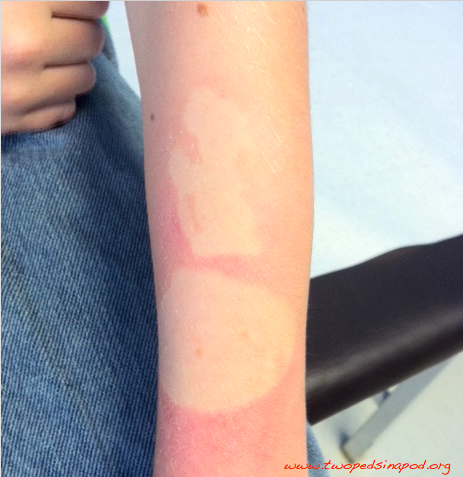
An inadvertent sunburn tattoo
I was greatly relieved recently when my teen arrived back from a music department trip to Disney without a sunburn. I had pictured a bright red cherry tomato coming off the plane. For those of us stuck in the middle of an East Coast perpetual rain cloud, it’s hard to believe that anyone outside of the South needs to worry about sunscreen. But soon enough, you will be scratching your head in a pharmacy aisle asking yourselves these questions:
What is SPF?
- SPF stands for Sun Protection Factor. SPF gives you an idea of how long it may take you to burn. SPF of 15 means you will take 15 times longer to burn without sunscreen. If you would burn after one minute in the sun, that’s only 15 minutes of protection!
- The American Academy of Pediatrics recommends applying a minimum of SPF 15 to children, while the American Academy of Dermatology recommends a minimum of SPF 30. We both apply sunscreen with SPF 30 to our own kids (mom hint: the high SPF sunscreens tend to be watery).
- Apply all sunscreen liberally and often– at least every two hours. More important than the SPF is how often you reapply the sunscreen. All sunscreen will slide off of a sweaty, wet kid. Even if the label says “waterproof,” reapply after swimming.
- Watch out for sunlight reflecting off water as well as sunburning on cool days. One pediatrician mom I know was aghast at seeing signs posted at her kid’s school reminding parents to apply sun screen “because it will be in the 80’s.” Kids burn on 60 degree days too. Lower temperatures do not necessarily mean less UV light.
Why does the bottle of sunscreen say to “ask the doctor” about applying sunscreen to babies under 6 months of age?
- Sunscreens were not safety-tested in babies younger than 6 months of age, so the old advice was not to use sunscreen under this age. The latest American Academy of Pediatrics recommendation is that it is more prudent to avoid sunburn in this young age group than to worry about possible problems from sunscreen. While shade and clothing are the best defenses against sun damage, you can also use sunscreen on exposed body areas.
- Clothing helps to block out sunlight. In general, tighter weaves protect better than loose weaves. Expensive “sun-protective clothing” is not always better— a study from 2014 suggests regular clothing may be as protective.
- Hats help prevent burns as well.
- Remember that babies burn more easily than older kids.
Which brand of sunscreen is best for babies and kids?
- Although clothing and shade block harmful rays the best, no one brand of sunscreen is better for children than another. We both tell our patients to apply a “test patch” the size of a quarter to an arm or leg of your baby and wait a few hours. If no rash appears, then use the sunscreen on whatever body parts you can’t keep covered by clothing. Look for UVA and UVB protection. More expensive does not always mean “better” and SPF above 50, according to the American Academy of Dermatology, has not been proven to be more effective than 50.
What do we know about the ingredients in sunscreen such as oxybenzone? In the United States sunscreen ingredients are considered medications and are regulated by the FDA. Oxybenzone is one of the oldest broad-spectrum (UVA and UVB) sunscreens, and was approved by the FDA in 1978. Oxybenzone’s main side effect is that it can cause allergic reactions of the skin. Recently, some people question whether oxybenzone can be a hormone disrupter and have questioned the use of oxybenzone. At this point, no hormonal disturbances have been clearly found in humans and the American Academy of Dermatology continues to support the use of oxybenzone.
Sunscreens made with zinc oxide and titanium dioxide (the white stuff on a lifeguard’s nose) have not garnered any questions nor sparked any debate about safety. Interestingly, zinc oxide is not only an effective sunscreen but also you will recognize it as the main ingredient in many newborn diaper rash creams.
Any info about the popular sprays? For spray formulations of any type of sunscreen, many doctors are concerned that any aerosolized oily substance will irritate the lungs and are looking into long term effects now. Avoid spraying sun screen near a child’s head to avoid inhalation. Also with the spray, some dermatologists worry that people might not be as thorough when they apply a spray as when they apply a cream.
Can I use last year’s sunscreen? Most sunscreens have expiration dates, as long as your bottle hasn’t expired, then it should be effective. In general, sunscreens are designed to last about three years before they expire.
Remember when we used to call sunscreen lotion “suntan lotion,” and when tolerating red, blistering shoulders was considered a small price to pay for a tan? Live and learn.
Naline Lai, MD and Julie Kardos
Two Peds in a Pod® rev ©2016 , 2015



